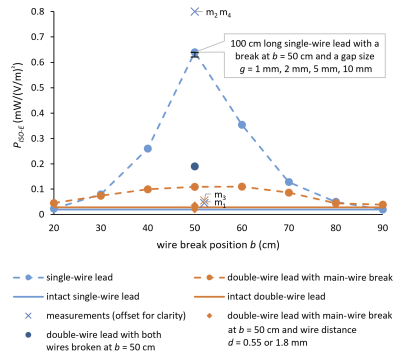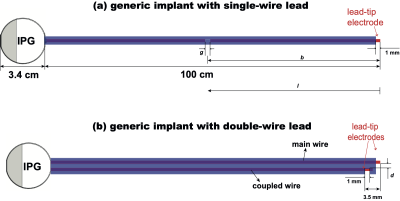Aiping Yao1, Tolga Goren1, Theodoros Samaras2, Niels Kuster1,3, and Wolfgang Kainz4
1IT'IS Foundation, Zurich, Switzerland, 2Department of Physics, Aristotle University of Thessaloniki, Thessaloniki, Greece, 3ITET, ETH Zurich, Zurich, Switzerland, 4FDA, Silver Spring, MD, United States
1IT'IS Foundation, Zurich, Switzerland, 2Department of Physics, Aristotle University of Thessaloniki, Thessaloniki, Greece, 3ITET, ETH Zurich, Zurich, Switzerland, 4FDA, Silver Spring, MD, United States
We studied the deposited lead-tip power of a generic implant, intact and with wire breaks at regular intervals. The lead-tip power enhancement reached 30-fold vs. the intact lead. The presence of a nearby intact wire, or even a nearby broken wire, reduced this enhancement factor to ~3-fold.

Deposited lead-tip power for the 100 cm long single-wire and double-wire lead (wire distance d =1.3 mm) with main-wire break under isoelectric conditions. Also, (i) 100 cm long single-wire lead with wire break at b = 50 cm and a gap size g = 1, 2, 5 and 10 mm, (ii) 100 cm long double-wire lead with wire distances d = 1.8 and 0.55 mm and the main-wire broken at b = 50 cm, and (iii) 100 cm long double-wire lead with wire distance d = 1.3 mm and both wires broken at b = 50 cm. Experimental validation measurements (m1 – m4) of the four 50 cm break cases are shown with slight offset for clarity.

